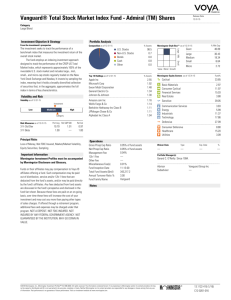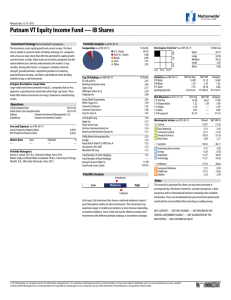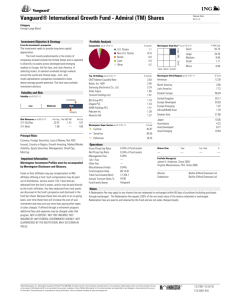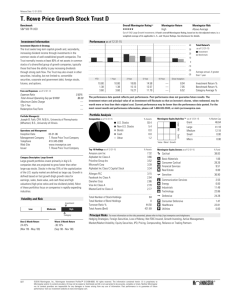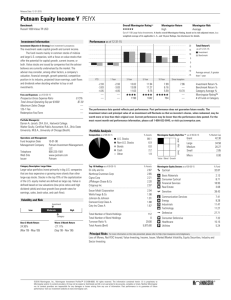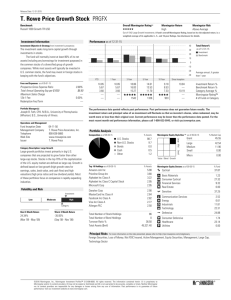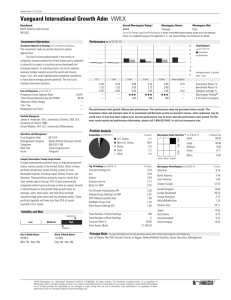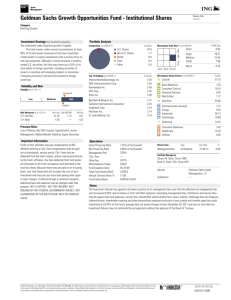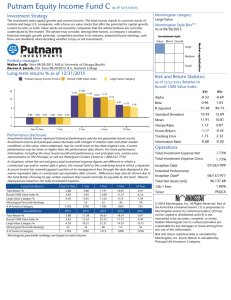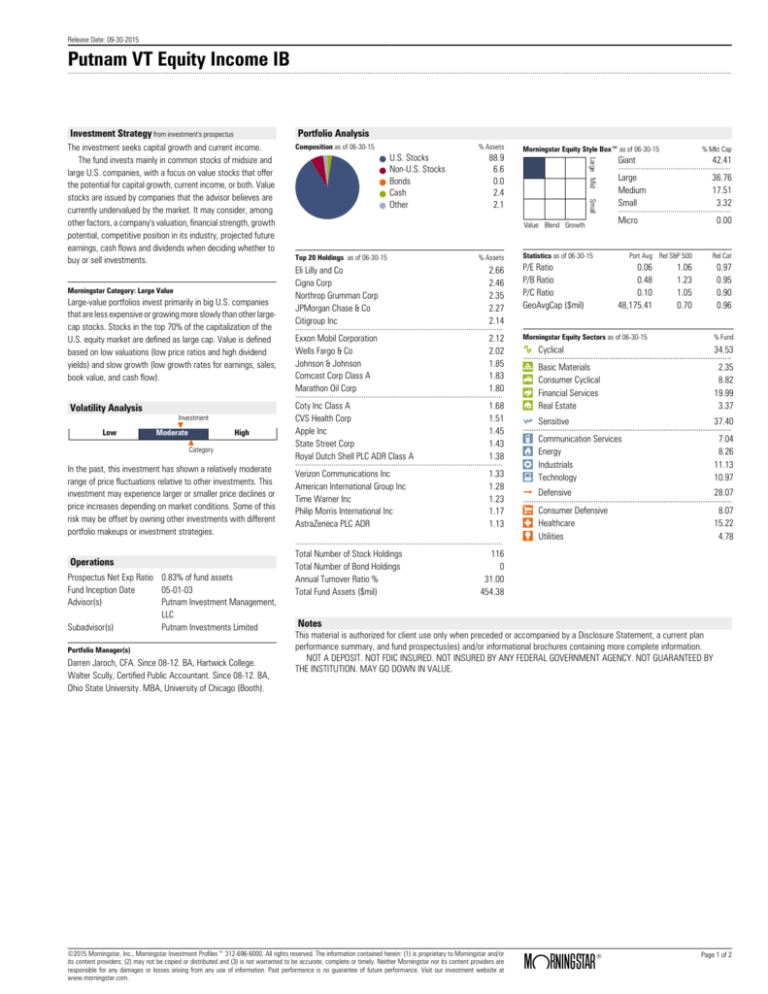
Release Date: 09-30-2015
Putnam
VT Equity Income IB
..........................................................................................................................................................................................................................................................................................................................................
Investment Strategy from investment's prospectus
Portfolio Analysis
Large-value portfolios invest primarily in big U.S. companies
that are less expensive or growing more slowly than other largecap stocks. Stocks in the top 70% of the capitalization of the
U.S. equity market are defined as large cap. Value is defined
based on low valuations (low price ratios and high dividend
yields) and slow growth (low growth rates for earnings, sales,
book value, and cash flow).
% Assets
U.S. Stocks
Non-U.S. Stocks
Bonds
Cash
Other
88.9
6.6
0.0
2.4
2.1
Top 20 Holdings as of 06-30-15
% Assets
Low
Investment
Moderate
High
Category
In the past, this investment has shown a relatively moderate
range of price fluctuations relative to other investments. This
investment may experience larger or smaller price declines or
price increases depending on market conditions. Some of this
risk may be offset by owning other investments with different
portfolio makeups or investment strategies.
Operations
Prospectus Net Exp Ratio 0.83% of fund assets
Fund Inception Date
05-01-03
Advisor(s)
Putnam Investment Management,
LLC
Subadvisor(s)
Putnam Investments Limited
Portfolio Manager(s)
Darren Jaroch, CFA. Since 08-12. BA, Hartwick College.
Walter Scully, Certified Public Accountant. Since 08-12. BA,
Ohio State University. MBA, University of Chicago (Booth).
% Mkt Cap
Giant
42.41
Large
Medium
Small
36.76
17.51
3.32
........................................................
........................................................
Micro
Value Blend Growth
Statistics as of 06-30-15
0.00
Port Avg Rel S&P 500
0.06
0.48
0.10
48,175.41
Rel Cat
Eli Lilly and Co
Cigna Corp
Northrop Grumman Corp
JPMorgan Chase & Co
Citigroup Inc
2.66
2.46
2.35
2.27
2.14
P/E Ratio
P/B Ratio
P/C Ratio
GeoAvgCap ($mil)
1.06
1.23
1.05
0.70
0.97
0.95
0.90
0.96
Exxon Mobil Corporation
Wells Fargo & Co
Johnson & Johnson
Comcast Corp Class A
Marathon Oil Corp
2.12
2.02
1.85
1.83
1.80
Morningstar Equity Sectors as of 06-30-15
% Fund
h Cyclical
34.53
Coty Inc Class A
CVS Health Corp
Apple Inc
State Street Corp
Royal Dutch Shell PLC ADR Class A
1.68
1.51
1.45
1.43
1.38
r
t
y
u
2.35
8.82
19.99
3.37
Verizon Communications Inc
American International Group Inc
Time Warner Inc
Philip Morris International Inc
AstraZeneca PLC ADR
1.33
1.28
1.23
1.17
1.13
.......................................................................................................
.......................................................................................................
Volatility Analysis
Morningstar Equity Style Box™ as of 06-30-15
Small
Morningstar Category: Large Value
Composition as of 06-30-15
Large Mid
The investment seeks capital growth and current income.
The fund invests mainly in common stocks of midsize and
large U.S. companies, with a focus on value stocks that offer
the potential for capital growth, current income, or both. Value
stocks are issued by companies that the advisor believes are
currently undervalued by the market. It may consider, among
other factors, a company's valuation, financial strength, growth
potential, competitive position in its industry, projected future
earnings, cash flows and dividends when deciding whether to
buy or sell investments.
.......................................................................................................
.......................................................................................................
Total Number of Stock Holdings
Total Number of Bond Holdings
Annual Turnover Ratio %
Total Fund Assets ($mil)
...............................................................................................
Basic Materials
Consumer Cyclical
Financial Services
Real Estate
j Sensitive
37.40
i
o
p
a
7.04
8.26
11.13
10.97
...............................................................................................
Communication Services
Energy
Industrials
Technology
k Defensive
28.07
s Consumer Defensive
d Healthcare
f Utilities
8.07
15.22
4.78
...............................................................................................
116
0
31.00
454.38
Notes
This material is authorized for client use only when preceded or accompanied by a Disclosure Statement, a current plan
performance summary, and fund prospectus(es) and/or informational brochures containing more complete information.
NOT A DEPOSIT. NOT FDIC INSURED. NOT INSURED BY ANY FEDERAL GOVERNMENT AGENCY. NOT GUARANTEED BY
THE INSTITUTION. MAY GO DOWN IN VALUE.
©2015 Morningstar, Inc., Morningstar Investment Profiles™ 312-696-6000. All rights reserved. The information contained herein: (1) is proprietary to Morningstar and/or
its content providers; (2) may not be copied or distributed and (3) is not warranted to be accurate, complete or timely. Neither Morningstar nor its content providers are
responsible for any damages or losses arising from any use of information. Past performance is no guarantee of future performance. Visit our investment website at
www.morningstar.com.
ß
®
Page 1 of 2
Disclosure
This material is authorized for client use only when preceded or
accompanied by a Disclosure Statement, a current plan
performance summary, and fund prospectus(es) and/or
informational brochures containing more complete
information.
Morningstar Style Box™
The Morningstar Style Box reveals a fund's investment strategy
as of the date noted on this report.
For equity funds the vertical axis shows the market
capitalization of the long stocks owned and the horizontal axis
shows investment style (value, blend, or growth).
For fixed-income funds, the vertical axis shows the credit
quality of the long bonds owned and the horizontal axis shows
interest rate sensitivity as measured by a bond's effective
duration.
Morningstar seeks credit rating information from fund
companies on a periodic basis (e.g., quarterly). In compiling
credit rating information Morningstar accepts credit ratings
reported by fund companies that have been issued by all
Nationally Recognized Statistical Rating Organizations
(NRSROs). For a list of all NRSROs, please visit http://
www.sec.gov/divisions/marketreg/ratingagency.htm.
Additionally, Morningstar accepts foreign credit ratings from
widely recognized or registered rating agencies. If two rating
organizations/agencies have rated a security, fund companies
are to report the lower rating; if three or more organizations/
agencies have rated a security, fund companies are to report
the median rating, and in cases where there are more than two
organization/agency ratings and a median rating does not exist,
fund companies are to use the lower of the two middle ratings.
PLEASE NOTE: Morningstar, Inc. is not itself an NRSRO nor does
it issue a credit rating on the fund. An NRSRO or rating agency
ratings can change from time-to-time and do not remove
market risk.
For credit quality, Morningstar combines the credit rating
information provided by the fund companies with an average
default rate calculation to come up with a weighted-average
credit quality. The weighted-average credit quality is currently
a letter that roughly corresponds to the scale used by a leading
NRSRO. Bond funds are assigned a style box placement of
"low", "medium", or "high" based on their average credit quality.
Funds with a low credit quality are those whose weightedaverage credit quality is determined to be less than "BBB-";
medium are those less than "AA-", but greater or equal to
"BBB-"; and high are those with a weighted-average credit
quality of "AA-" or higher. When classifying a bond portfolio,
Morningstar first maps the NRSRO credit ratings of the
underlying holdings to their respective default rates (as
determined by Morningstar's analysis of actual historical default
rates). Morningstar then averages these default rates to
determine the average default rate for the entire bond fund.
Finally, Morningstar maps this average default rate to its
corresponding credit rating along a convex curve.
For interest-rate sensitivity, Morningstar obtains from fund
companies the average effective duration. Generally,
Morningstar classifies a fixed-income fund's interest-rate
sensitivity based on the effective duration of the Morningstar
Core Bond Index (MCBI), which is currently three years. The
classification of Limited will be assigned to those funds whose
average effective duration is between 25% to 75% of MCBI's
average effective duration; funds whose average effective
duration is between 75% to 125% of the MCBI will be classified
as Moderate; and those that are at 125% or greater of the
average effective duration of the MCBI will be classified as
Extensive.
For municipal bond funds, Morningstar also obtains from
fund companies the average effective duration. In these cases
static breakpoints are utilized. These breakpoints are as follows:
(i) Limited: 4.5 years or less; (ii) Moderate: more than 4.5 years
but less than 7 years; and (iii) Extensive: more than 7 years. In
addition, for non-US taxable and non-US domiciled fixed income
funds static duration breakpoints are used: (i) Limited: less than
or equal to 3.5 years; (ii) Moderate: greater than 3.5 and less
than equal to 6 years; (iii) Extensive: greater than 6 years.
Portfolio Statistic Definitions
P/E Ratio Price/Earnings (P/E) Ratio is a stock's current price
divided by the company's trailing 12-month earnings per
share.
P/B Ratio Price/Book (P/B) Ratio is the weighted average of the
price/book ratios of all the stocks in a portfolio.
P/C Ratio Price/Cash (P/C) Ratio represents the weighted
average of the price/cash-flow ratios of the stocks in a
portfolio.
GeoAvgCap Geometric Average Cap is the geometric mean of
the market capitalization for all of the stocks the portfolio
owned.
Investment Risk
Foreign Securities Funds/Emerging Markets Funds: The investor
should note that funds that invest in foreign securities involve
special additional risks. These risks include, but are not limited
to, currency risk, political risk, and risk associated with varying
accounting standards. Investing in emerging markets may
accentuate these risks.
Sector Funds: The investor should note that funds that invest
exclusively in one sector or industry involve additional risks. The
lack of industry diversification subjects the investor to increased
industry-specific risks.
Non-Diversified Funds: The investor should note that funds that
invest more of their assets in a single issuer involve additional
risks, including share price fluctuations, because of the
increased concentration of investments.
Small Cap Funds: The investor should note that funds that invest
in stocks of small companies involve additional risks. Smaller
companies typically have a higher risk of failure, and are not as
well established as larger blue-chip companies. Historically,
smaller-company stocks have experienced a greater degree of
market volatility than the overall market average.
Mid Cap Funds: The investor should note that funds that invest
in companies with market capitalizations below $10 billion
involve additional risks. The securities of these companies may
be more volatile and less liquid than the securities of larger
companies.
High-Yield Bond Funds: The investor should note that funds that
invest in lower-rated debt securities (commonly referred to as
junk bonds) involve additional risks because of the lower credit
quality of the securities in the portfolio. The investor should be
aware of the possible higher level of volatility, and increased
risk of default.
Tax-Free Municipal Bond Funds: The investor should note that
the income from tax-free municipal bond funds may be subject
to state and local taxation and the Alternative Minimum Tax.
©2015 Morningstar, Inc., Morningstar Investment Profiles™ 312-696-6000. All rights reserved. The information contained herein: (1) is proprietary to
Morningstar and/or its content providers; (2) may not be copied or distributed and (3) is not warranted to be accurate, complete or timely. Neither Morningstar
nor its content providers are responsible for any damages or losses arising from any use of information. Past performance is no guarantee of future
performance. Visit our investment website at www.morningstar.com.
ß
®
Page 2 of 2

